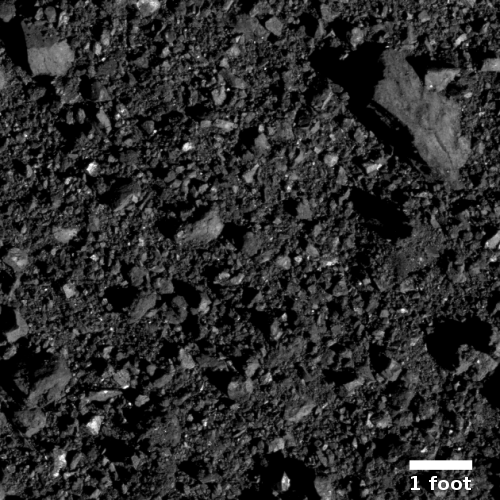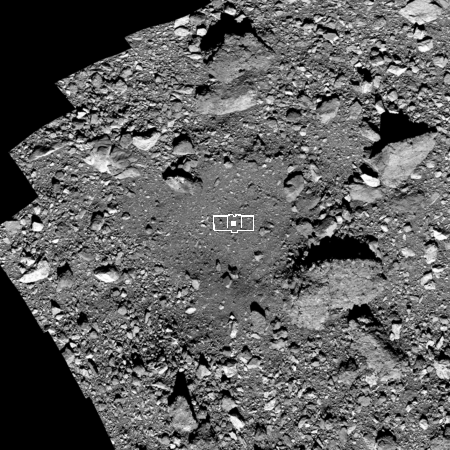OSIRIS-REx’s sample grab location on Bennu
On April 14th engineers for the probe OSIRIS-REx will do the first of two dress rehearsals of their planned touch-and-go sample grab from the asteroid Bennu, presently planned for August 25.
The image to the right was taken on March 3, 2020 from about 1,000 feet away during the spacecraft’s third reconnaissance phase, and is centered on that touch-and-go site, dubbed Nightingale by the science team. It illustrates why that sample grab carries risks that were unexpected. As they point out on the image’s release page, “the rock in the [upper right] of the image is 2 ft (70 cm) long, which is about the length of a small ice chest.” Moreover, across the entire touchdown site are numerous other rocks ranging in size from fists to laptops.
When they designed the mission, they had assumed there would be places on Bennu’s surface made up mostly of dust. areas where such dust would have gathered into ponds, as seen in other asteroids. The expectation also assumed these areas would be larger than any of the smooth areas found on Bennu. As they have noted:
The original mission plan envisioned a sample site with a diameter of 164 feet (50 meters). While the crater that hosts Nightingale is larger than that, the area safe enough for the spacecraft to touch is much smaller – approximately 52 feet (16 meters) in diameter, resulting in a site that is only about one-tenth the size of what was originally envisioned.
In addition, they designed the equipment to pick up pebbles smaller then an inch across (0.8 inches to be exact). While this site has plenty of pebbles that size or smaller, it also has lots of much larger rocks, objects that not only could get in the way of the sample grab, but could very well damage the touch-and-go equipment.
Worse, the target crater, about 460 feet in diameter, is surrounded by a number of much larger boulders that, if they don’t avoid, could destroy OSIRIS-REx itself. The mosaic to the right was assembled from photos taken in October during the first reconnaissance phase. The smoother area in the center is the relatively fresh crater in which the Nightingale touch-and-go site is located. The white dot indicates the approximate size of the image above, with the overall footprint of OSIRIS-REx overlaid to illustrate the tight constraints they are working under.
While it is likely that they can make this touch-and-go precise enough to avoid the large boulders, the average size of the smaller pebbles I think poses a bigger problem. Until the arrival of both Hayabusa-2 at Ryugu and OSIRIS-REx at Bennu, we had never seen a rubble-pile asteroid up close, and really had no idea what to expect. The lack of dust at both of these asteroids has astonished scientists. What they have found instead is literally a pile of pebbles, rocks, and boulders held together only by gravity. Think of a pile of gravel in a quarry. Nothing is cemented together, at least on the visible surface.
I am not sure the sample grab equipment will be able to get anything, designed as it is for much smaller dust particles. And even if they do, the lack of adhesion and the very very low gravity means that the slightest disturbance could dislodge large rocks nearby, threatening the entire spacecraft. They will definitely have to get away from here after touchdown as quickly as possible.
On Christmas Eve 1968 three Americans became the first humans to visit another world. What they did to celebrate was unexpected and profound, and will be remembered throughout all human history. Genesis: the Story of Apollo 8, Robert Zimmerman's classic history of humanity's first journey to another world, tells that story, and it is now available as both an ebook and an audiobook, both with a foreword by Valerie Anders and a new introduction by Robert Zimmerman.
The print edition can be purchased at Amazon or from any other book seller. If you want an autographed copy the price is $60 for the hardback and $45 for the paperback, plus $8 shipping for each. Go here for purchasing details. The ebook is available everywhere for $5.99 (before discount) at amazon, or direct from my ebook publisher, ebookit. If you buy it from ebookit you don't support the big tech companies and the author gets a bigger cut much sooner.
The audiobook is also available at all these vendors, and is also free with a 30-day trial membership to Audible.
"Not simply about one mission, [Genesis] is also the history of America's quest for the moon... Zimmerman has done a masterful job of tying disparate events together into a solid account of one of America's greatest human triumphs."--San Antonio Express-News



